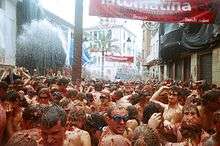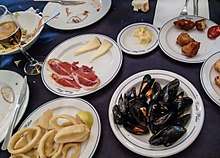Buñol
With a population of just under 10,000, Buñol is the largest town in La Hoya, the mountainous western area of Valencia province.

Understand
Buñol (from Arabic al-Buniúl) has been inhabited continuously for at least 50,000 years, with archaeological remains from the Paleolithic, Iberian, and Roman eras. After the Christian Reconquista in the 13th century the town became a border post between the kingdoms of Valencia and Castile, and remained populated mostly by Moriscos until their expulsion from Spain in 1602, which brought on a regional economic collapse.
Today agriculture and industry are the primary economic activities. The climate is typical Mediterranean, with mild winters (and occasional snow) and hot summers.
- 🌍 Tourist Info, Plaza Castillo, s/n (Casa Señorial), ☎ +34 962 503 886. M-F 10:30-14:00, Sa Su 10:00-14:00.
Get in
By plane
Valencia International Airport (VLC IATA). Has daily flights to major cities in Europe and has seasonal flights to New York City and then drive west along the Autovia del Este.
By train
- 🌍 Estación de Tren de Buñol (Buñol Train Station). Medium-distance trains connect the city with Madrid, Cuenca, and Valencia. From Valencia, Renfe regional train line C3 depart three times daily Estació de València Nord, with a round-trip ticket costing €3.70 and the journey lasting just over an hour.
By bus
Autobuses Buñol (tel. +34 963 491 425) runs frequent buses from Valencia, with the Buñol 🌍 bus stop located on Av Beltran Vaguena, near the Plaza de la Diputación.
Get around
The central core of Buñol is small and easily navigable by foot. To go further distances, the town has a municipal bus service which connects the centre with the outlying barrios, traveling in a circular route. Buses operate Monday through Saturday, departing every half-hour or hour; a schedule and route map can be downloaded here.
See
- 🌍 Castillo de Buñol (Buñol Castle) (centre of town). W-F 10:30-14:00, Sa Su 10:00-14:00. Built by the Moors in the 11th and 12th centuries atop an earlier Roman fortification, the castle was captured during the Christian Reconquista in 1238 and later modified. It was used as a barracks during the 18th and 19th centuries, and now houses a small museum with displays documenting the town's history. €3 (adults), €1 (seniors/students/children under 14).
- 🌍 Iglesia de San Pedro Apóstol (Church of Saint Peter), Plaza del Pueblo, 10. The church was built in the 18th century in the Neoclassical style, and remodeled several times.
- 🌍 Ermita de San Luis Beltrán (Hermitage of Saint Louis Bertrand), Paseo San Luis, 6. The small chapel was built in the 18th century, by San Luis spring.
- 🌍 Torre de telegrafía óptica (Optical telegraph tower). The ruined optical telegraph tower dates from the mid-19th century and is one of a string of such towers between Valencia and Madrid. Good views of the area can be had from the top.
Do
Buñol is a beautiful town, but the most beautiful are its natural places on the outskirts of the city which are great for walking around. 🌍 Parque el Planell is a large park where people usually go for a walk and play sports.
Buñol is famous for its two music wind ensembles, which are the most important in the province of Valencia.
Festivals

- Falles (Fallas), in the old town and the port district. 12-19 March. As elsewhere in Valencia, Buñol celebrates Falles with the cridà (opening call of the festivities), the plantà (assembly of the satirical falla monuments to be eventually burnt), l'Ofrena (offering of flowers to the Virgen de los Desamparados), the mascletà (gunpowder demonstrations), fireworks, and finally the cremà (burning of the fallas).
- 🌍
La Tomatina. Last Wednesday of August. Designated as a 'Festival of International Touristic Interest' by the Spanish Government, upwards of 40,000 people descend on the town annually for a massive tomato fight that literally stains the entire town red. It is believed to have begun in 1945, when some youths threw tomatoes at town authorities in retaliation for being denied permission to participate in a parade. The incident was repeated for several years until 1950, when after an attempt by Francoist authorities to halt the practice most of the townspeople began participating and it became a regular event. €10.
- As a means of crowd control the town has begun selling tickets to the event, which much be purchased in advance online. It is advisable to wear old clothing to the event, and to protect your camera should you bring one. The Tomatina formally lasts only one hour, from noon until 13:00.
Buy
- 🌍 Mercadillo (street market), C/ Valle de Andorra. Th mornings. A weekly street market for local produce and other goods.
Eat

Due to its inland location, traditional Buñol cuisine is largely based on rice, vegetables, and game, and includes such dishes as arroz con bledas, aka arroz con acelgas (rice with chard and snails), olla podrida (vegetable and pork stew), and perdiz en escabeche (partridge in pickle sauce), a mainstay of Castilian cooking.
- 🌍 Bar-Restaurante Acacia, Paseo San Luis, s/n, ☎ +34 962 501 350, e-mail: restaurante.acacia@hotmail.com. Sep-Jun: Sa Su and holidays 10:00-22:00; July: F-Su evenings; Aug: daily. Pleasantly situated in a park with both indoor and outdoor seating, the large restaurant serves traditional Buñol rice dishes as well as lighter fare. The wood-fired paella is especially recommended. Set menu €15-22.
- 🌍 Posada Venta Pilar, Avda de Benito Pérez Galdós, 5, ☎ +34 962 500 923. M-Th 10:00-20:00, F Sa 10:00-24:00, Su 10:00-18:00. Located in a 17th-century posada (an inn used to accommodate both travellers and horses), the posada today also has a large, reliable restaurant serving up classic Valencian dishes. Dishes are available à la carte or in a set menu, with very generous portions. Set menu €9+.
Drink
Sleep
- 🌍 Casa Rural Castillo de Buñol, C/ Quevedo, 10, ☎ +34 661 302 178, e-mail: ruralcastillobunyol@hotmail.com. Rooms have a shared bathroom; shared kitchen and garden available. Free Wi-Fi, no onsite parking. Doubles €36-40, including breakfast.
- 🌍 Hotel Condes de Buñol, Avda Blasco Ibáñez, 13, ☎ +34 962 504 852, e-mail: info@hotelcondesdebunol.com. A family-run hotel, operational since 2001. Has an onsite bar and restaurant, free parking, and free Wi-Fi. Pets permitted on request for no extra charge. Doubles €48, including breakfast.